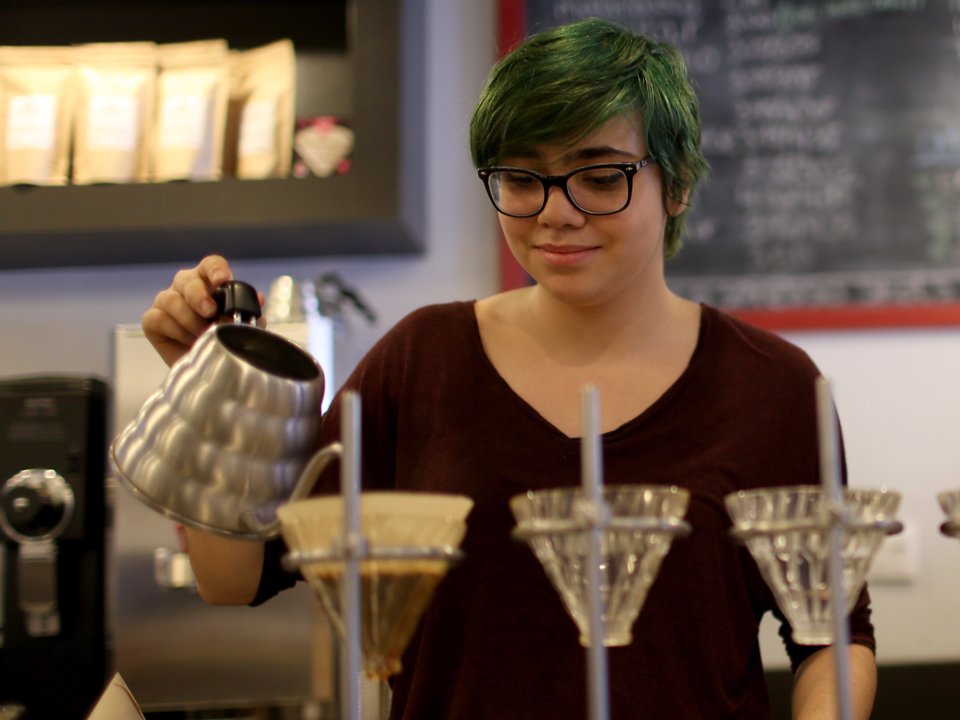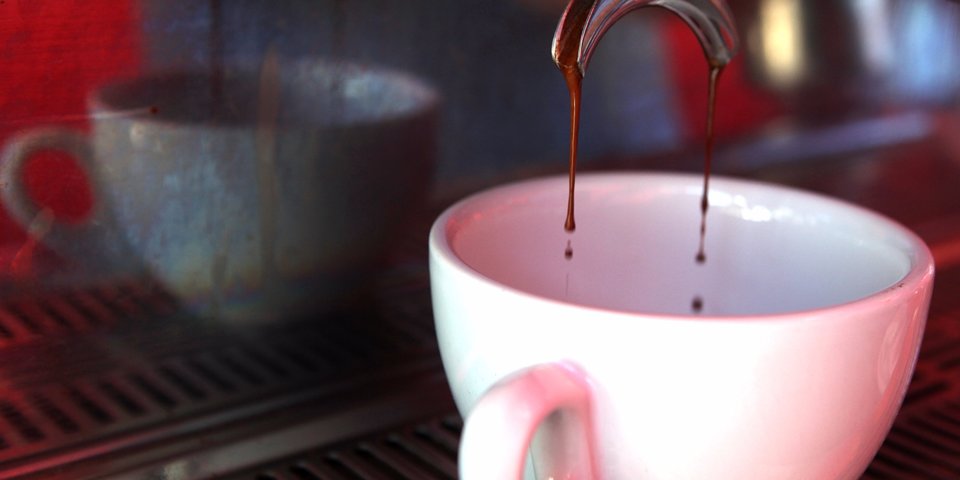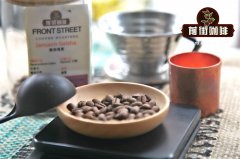Scientific explanation: why coffee produced in coffee shops tastes better than home brewing?
Professional coffee knowledge exchange more coffee bean information please follow the coffee workshop (Wechat official account cafe_style)
The taste of coffee bought in a coffee shop is sometimes very different from that of home brewing for many reasons: the type of coffee beans, water, grinding, freshness of coffee beans, etc.
There are two major systems of coffee brewing-immersion extraction and filtration extraction. According to the individual situation, we mainly control the flavor of coffee by adjusting water temperature, grinding degree and extraction time.
Calcium ions and bicarbonates (hard water and soft water) in water can affect the sour taste of coffee. Unfortunately, we have little control over the composition of tap water.
Coffee beans produce carbon dioxide and other flavor-affecting volatiles during roasting, but they gradually decrease over time, so most coffee shops reuse coffee beans after baking for a period of time (usually 4-7 days). And try to use it up within a month.
Coffee is unique in handmade drinks, because there are so many variables in coffee brewing, and the subsequent impact on the quality of coffee is very obvious during consumption. In contrast, if consumers choose to drink beer or wine, the only control variable is probably the temperature when drinking.

So back to the subject: why does the coffee brewed by baristas in coffee shops always taste different from the coffee brewed at home?
First of all, it may benefit from years of training of baristas, but it is more likely that they know how to use the principles of chemistry and physics. Baristas have lower barriers to entry, but baristas who can brew a good cup of coffee are often high achiever Benba-temperature, hydrochemistry, particle size distribution, gouache ratio, time, and, more importantly, coffee raw bean quality and coffee roasting. These variables play a key role in making delicious coffee. We must learn how to control these variables so that the quality of coffee can be stably reproduced.
What's in a cup of coffee?
Excluding the psychological cues and environmental factors that baristas brew in coffee shops, we also need to consider the brewing method of coffee itself.
We humans seem to particularly like drinks that contain coffee ingredients (organic acids, Mena products, esters, heterocycles, etc.), mainly filtered coffee with a coffee concentration of 1.2-1.5%, and espresso with a concentration of 8-10%. Extraction concentrations beyond these ranges will be more difficult to implement. Of the limited technologies that can reach an extraction concentration of 8-10%, espresso machines are the most familiar.

There are many ways to get a cup of coffee with a concentration of 1.2-1.5%: hand-brewed coffee, Turkish coffee, Arabica coffee, Arizona pressure, French kettle, siphon pot or American drip filter-each method can brew delicious coffee close to this concentration. These brewing methods also have an advantage over espresso: cheaper. So when we brew it at home, most of it is filtered coffee with a coffee concentration of about 1.2-1.5%. Of course, the espresso machine can also make a drink close to this concentration: Americano, as long as you dilute the espresso with water.
All of the above methods produce roughly the same concentration of coffee. Then why do they taste so different?
The low concentration coffee brewing method is divided into two extraction systems-the immersion extraction system in which the coffee is completely immersed in water (such as the autoclave, the smart cup), and the filtration extraction system (such as hand brewing coffee) that allows water to flow through the coffee powder.
From a physical point of view, the main difference between the two is that the extraction temperature of coffee particles in the immersion extraction system is higher. The slowest part of coffee extraction is not the rate of dissolution of compounds on the surface of coffee particles. On the contrary, it is the rate at which coffee flavor moves out of the solid particles and dissolves into water, which increases as the temperature increases. Therefore, the higher extraction temperature means that more delicious compounds hidden inside the coffee particles will be dissolved.
But higher temperatures also allow more compounds that we don't need to dislike to dissolve in water. The American Fine Coffee Association (SCAA) has created a coffee flavor wheel that makes it easy for us to talk about these flavors-from green / botanical, to paper / moldy, to brown sugar or dried fruit.
The filtration extraction system is more complex than other systems. Unlike the immersion extraction system in which the extraction degree can be controlled by controlling the extraction time, the extraction time of the filtration extraction system often depends on the grinding size, because the grinding thickness affects the flow rate. If it is intended to increase the extraction rate by grinding finer, the cooking time will change as the water seeps more slowly in the finer powder layer. The ratio of water to coffee powder is also important in the brewing process. The ratio of water to powder can be increased by using less coffee powder, but as the quality of coffee decreases, so does the brewing time.
You see, the parameters of the filtration extraction system often affect the whole body, which is much trickier than the immersion extraction system.
Try to control other variables
Even if you can adjust your cooking scheme and equipment to accurately mimic your favorite barista, your home-made products are still likely to taste different from those of coffee shops. There are three subtle factors that have a great impact on the quality of coffee: hydrochemistry, particle size distribution produced by bean grinders and freshness of coffee beans.
First of all, hydrochemistry: since coffee is an acidic drink, the acidity of the water used for brewing will have a great influence.
Brewing water (that is, soft water) containing low concentrations of calcium ions and bicarbonate ions (HCO 3 -) will flush out highly acidic coffee, sometimes described as sour. Boiling water with high concentrations of bicarbonate ions (usually hard water) will produce bicarbonate, which tends to highlight bitterness and astringency because bicarbonate has neutralized most of the acidic flavor of coffee.
Ideally, we would like to use moderately hard water to make coffee. But there's a good chance you don't even know the concentration of bicarbonate in your tap water, and a small change can make a big difference. To taste the effect, try brewing coffee with bottled distilled water with the lowest bicarbonate concentration. The effect of water on the taste of coffee will be clear at a glance.
The particle size distribution produced by the bean grinder is also important:
Every coffee lover will seriously remind you not to use a blade-type "chopping" bean machine. Because they produce a seemingly random size distribution of coffee powder: from the powder to the whole coffee bean is possible to coexist. The other is the knife plate grinder, which has two toothed cutters that make the coffee powder finer and finer by grinding. Only when the coffee powder is fine enough can it come out through the gap.
However, when using the knife head grinder, how to optimize the grinding scale is also controversial. One view is that coffee powder should be ground as finely as possible to maximize the surface area and extract a higher concentration of delicious flavor. Another point of view advocates rough grinding as much as possible to minimize the production of ultra-fine powder particles that bring negative flavor.
The most useful advice here is: it doesn't make much sense who is right or wrong, just choose the degree of grinding that suits you best according to your taste preferences.
Finally, the freshness of the coffee itself is crucial.
Roasted coffee beans contain large amounts of carbon dioxide and other volatiles, which are trapped in the solid matrix of coffee beans: these gaseous organic molecules will escape over time. The less volatile matter, the lighter the taste of coffee. Most cafes do not use coffee beans that have been roasted for more than a month, which emphasizes the importance of using freshly roasted coffee beans.
The rate of exhaust volatilization can be slowed down by freezing coffee beans. Although freezing coffee in a sealed container can significantly prolong its freshness, you'd better not refrigerate the beans in an open container (unless you taste the hodgepodge in the fridge).
So don't be sad, it's not surprising that the carefully brewed coffee at home doesn't taste the same as the coffee you buy in a cafe. The key is to understand which factors are hardware configuration problems and which gaps are caused by human operation.
There are many variables that seem to have to be debated in order to make the perfect cup of coffee. But rest assured that most of these variables are not optimized by mathematical algorithms, but are summed up by some people's tongue senses. So, whether it's science or metaphysics-the most important thing is that you think the coffee you make is good, well, it's even better if it tastes good every time it comes out.
END
Important Notice :
前街咖啡 FrontStreet Coffee has moved to new addredd:
FrontStreet Coffee Address: 315,Donghua East Road,GuangZhou
Tel:020 38364473
- Prev

Native Ethiopian coffee native species Ethiopian coffee bean species
Professional coffee knowledge exchange more coffee bean information please follow the coffee workshop (Wechat official account cafe_style) in the global coffee, Arabica species account for about 70% of the total output, has important commercial value. Arabica species spread to all parts of the world from the Arabian Peninsula, and subspecies such as Tibica species and slope species appeared according to the route of transmission, followed by mutation and crossing.
- Next

Factors affecting Coffee pattern how to make Coffee pattern
Professional coffee knowledge exchange more coffee bean information please follow the coffee workshop (Wechat official account cafe_style) as a barista, coffee is our business card, when customers order a cup of latte, we also hope to make a nice cup of flowers. Every time when customers are surprised or rejoiced by the pattern of flowers in the cup, it is also the happiest for every barista.
Related
- Beginners will see the "Coffee pull flower" guide!
- What is the difference between ice blog purified milk and ordinary milk coffee?
- Why is the Philippines the largest producer of crops in Liberia?
- For coffee extraction, should the fine powder be retained?
- How does extracted espresso fill pressed powder? How much strength does it take to press the powder?
- How to make jasmine cold extract coffee? Is the jasmine + latte good?
- Will this little toy really make the coffee taste better? How does Lily Drip affect coffee extraction?
- Will the action of slapping the filter cup also affect coffee extraction?
- What's the difference between powder-to-water ratio and powder-to-liquid ratio?
- What is the Ethiopian local species? What does it have to do with Heirloom native species?

